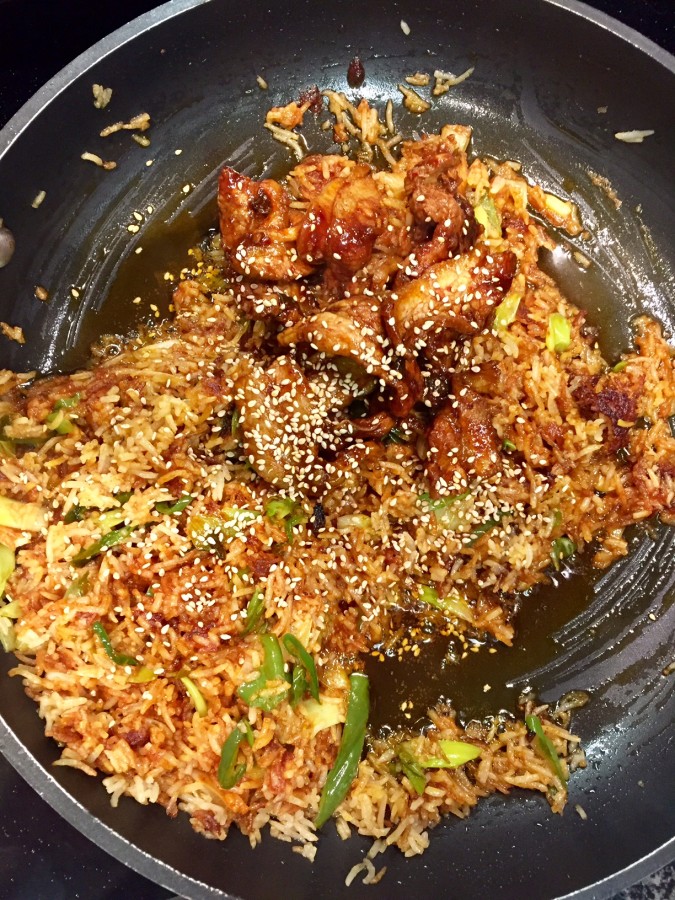Mildly Insane Korean Feast

I just love the flavors of Korean food. I’ve never been to Korea; in fact I don’t think I’ve ever been to a “Little Korea” in any of the cities where I’ve lived. That should be a goal for me.
In the meantime, I must content myself with the beautiful cookbook “Koreatown,” by chef Deuki Hong and writer Matt Rodbard, given to me by John, with the subtlest possible nudge toward learning to cook this complex and spicy cuisine for us here at home.
Now, at first, as I described to you earlier this year, I slavishly followed the recipes. This uncharacteristic behavior on my part was due to my complete ignorance about the more exotic ingredients in the list, and my unfamiliarity with some of the cooking techniques. But you know me — eventually I will mess around with a recipe, generally to simplify it, once I understand the goal. So after several months of being a good girl and doing exactly what Deuki and Matt told me to do, I have branched out, or rather drawn in, and combined the ideas and flavors of three of their most wonderful recipes into one gorgeous Korean feast.
These three recipes, should you find yourself in possession of “Koreatown,” are “Our Mildly Insane Kimchi Bokkeumbap,” (p. 74), “This Is Not a Bibimbap Recipe,” (p. 78), and finally the crowning glory of “Jeyuk Bokkeum,” (p. 122). As Matt describes, any Korean recipe with the word “Bokkeum” in its title means it will be stir-fried over high heat. “Bibimbap” refers to the basic concept of a mixed-rice dish, with many, many variations all over Korea and around the world.
I have a very strict caveat here. DO NOT substitute anything else for “gochugaru” and “gochujang.” Buy the exact thing. “Gochugaru” is a fiercely flavorful red pepper powder. You can buy it here online in the UK and here in the US. “Gochujang” is a glorious paste of red peppers with lots of other ingredients like glutinous brown rice, garlic and soybeans. You can buy it here in the UK, and here in the US.
Once you’ve made the marinade for the pork belly and mixed it well, you may leave it in the fridge all day or overnight. I’ve done both these, and I’ve also made the dish without any time to marinate. It is delicious every single way.
You will notice that I list the kimchi in the pork ingredients as “optional.” I do not like kimchi, but John absolutely adores it. Up to you!
The beauty of my instructions for this supper, if I do say so myself, is that they combine the flavors, textures and experience of these three dishes into one, the whole lot beautifully garnished and topped with a fried egg. As we all know, a fried egg improves anything. With apologies to Deuki and Matt, and with thanks to them as well, I give you:
Kristen’s Mildly Insane Korean Pork Belly and Rice Feast
(serves about 4)
for pork:
1 kilo/2 pounds pork belly, skin removed, sliced very thin
3 tbsps gochujang
2 tbsps gochugaru
2 tbsps honey
2 tbsps mirin
3 garlic cloves, minced
1 2‑inch piece ginger, grated
2 tbsps dark soy sauce
2 tsps sesame oil
1 tbsps water
2 red peppers, sliced thin
1 bunch spring onions, sliced crossways, both white and green parts
1/2 cup chopped kimchi (optional)
1 tbsp sesame seeds
for rice:
2 tbsps softened butter
2 tbsps gochujang
2 tbsps duck, goose or bacon fat
3 cups cooked basmati rice (the authors suggest day-old leftover Chinese delivery rice!)
2 cloves garlic, grated
1‑inch piece ginger, grated
1 bunch spring onions, sliced crossways, both white and green parts
for garnish:
1 carrot, julienned
4 radishes, or 1 mooli, julienned
1 small cucumber, deseeded and sliced thin
1/2 kohlrabi bulb, peeled and julienned
1 tsp butter
2 eggs
For this dish, you will need two large, nonstick frying pans.
For the pork belly, combine all the ingredients up to the spring onions. Marinate as long as you like, or not at all. Heat the second frying pan until very hot, then add the sliced peppers, pork and its marinade. Fry over very hot heat until the pork is cooked through, about 10–15 minutes. At the end, add half the spring onions and kimchi (if using) and mix well. Top with the sesame seeds and the other half of the spring onions, so they’re crunchy.
Meanwhile, for the rice, in a small bowl mix the soft butter and the gochujang. Set aside. Melt the duck, goose or bacon fat in one of the frying pans and when it is very hot, add the cooked rice. Fry without stirring until the bottom is a bit crunchy, about 10–15 minutes, but do not allow to burn. Stir through the butter mixture, ginger and garlic and cook till garlic is soft. Garnish with the spring onions.
To serve, place a mound of the rice in a large bowl, then top with a serving of pork. Arrange the garnishes prettily. Very quickly, fry the eggs in the butter without turning them. Lay one egg on top of each serving. Enjoy!


